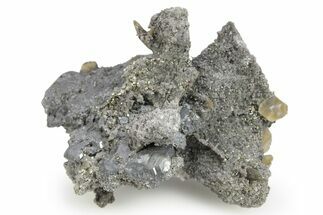This Specimen has been sold.
4.3" Iridescent, Rainbow-Pyrite Septarian Nodule - Russia
This is a gorgeous, iridescent "rainbow-pyrite" encrusted septarian (siderite concretion) nodule half that was collected near Ulyanovsk Oblast, Russia. These concretions occur in clays that have undergone shrinkage, where cracks will appear at the center following dehydration. Septarian concretions often contain calcite, though in some cases they can contain pyrite.
It is accompanied by an acrylic display stand to assist with presentation.
It is accompanied by an acrylic display stand to assist with presentation.
About Septarian
Septarian or septarian nodules are concretions containing angular cavities or cracks, called "septaria", filled with calcite and aragonite. A concretion is a hard, compact mass of rock that often forms around decaying organic matter. In the case of septarian nodules, the concretions formed around decaying sea life in a marine environment.
The exact mechanism for how the cracks form in the concretions is a mystery. One possible mechanism is the dehydration of the clay-rich core of a concretion, causing it to shrink and crack. The cracks could also be caused by gas expansion produced by the decaying organic matter within a concretion. Earthquakes have also been suggested as yet another mechanism.
The cracks in the concretions are then filled in with minerals such as calcite (yellow), aragonite (brown), and sometimes pyrite, causing very interesting patterns. They have often been described as looking like dragon's skin. They are frequently found as geodes with hollow, calcite crystal-filled cavities. More rarely, the fossils that originally started the formation of the concretion are still preserved in the septarian.
Septarian or septarian nodules are concretions containing angular cavities or cracks, called "septaria", filled with calcite and aragonite. A concretion is a hard, compact mass of rock that often forms around decaying organic matter. In the case of septarian nodules, the concretions formed around decaying sea life in a marine environment.
The exact mechanism for how the cracks form in the concretions is a mystery. One possible mechanism is the dehydration of the clay-rich core of a concretion, causing it to shrink and crack. The cracks could also be caused by gas expansion produced by the decaying organic matter within a concretion. Earthquakes have also been suggested as yet another mechanism.
The cracks in the concretions are then filled in with minerals such as calcite (yellow), aragonite (brown), and sometimes pyrite, causing very interesting patterns. They have often been described as looking like dragon's skin. They are frequently found as geodes with hollow, calcite crystal-filled cavities. More rarely, the fossils that originally started the formation of the concretion are still preserved in the septarian.
SPECIES
Siderite & Pyrite
LOCATION
Ulyanovsk, Ulyanovsk Oblast, Russia
SIZE
Entire specimen: 4.3 x 4.15 x 3.3"
CATEGORY
ITEM
#207240
 Reviews
Reviews















